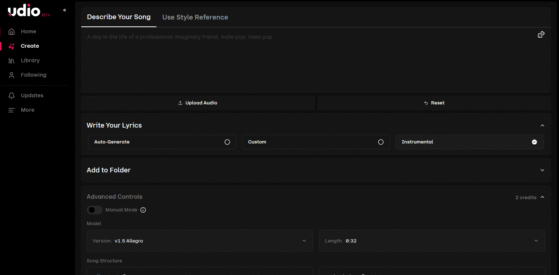 Introduction
Introduction
In the ever-evolving landscape of music production, UDIO stands out as a revolutionary tool that leverages artificial intelligence to generate music based on text prompts. Whether you’re a seasoned producer or a budding musician, understanding how to harness UDIO’s capabilities can significantly enhance your creative process. This guide delves into the nuances of UDIO, offering insights and strategies to maximize the quality of your AI-generated music.
Understanding UDIO’s Core Functionality
At its core, UDIO transforms textual descriptions into musical compositions. By inputting prompts that specify genre, mood, tempo, and lyrical themes, users can generate unique tracks tailored to their vision. The platform’s intuitive interface allows for customization, enabling users to choose between auto-generated lyrics, custom lyrics, or instrumental tracks.
For instance, a prompt like “An upbeat pop track with energetic rhythms and uplifting lyrics about chasing dreams” would guide UDIO to produce a song aligning with that description. The specificity of your prompt directly influences the output’s relevance and quality.
Crafting Effective Prompts
The art of prompt crafting is pivotal in achieving desired results with UDIO. Here are some strategies to consider:
- Be Specific: Clearly define the genre, mood, instruments, and lyrical themes. For example, “A melancholic acoustic ballad featuring piano and violin, exploring themes of lost love.”
- Use Descriptive Language: Incorporate adjectives and imagery to convey the desired atmosphere. Phrases like “haunting melodies” or “driving basslines” provide clearer direction.
- Reference Artists or Songs: Mentioning specific artists or tracks can help UDIO emulate a particular style. For example, “In the style of early 2000s Coldplay.”
- Remember, the more detailed your prompt, the more tailored the output will be.
Utilizing UDIO’s Advanced Features
Beyond basic song generation, UDIO offers advanced functionalities to refine your music:
- Remix and Extend: Modify existing tracks by altering sections or adding new elements. This is useful for experimenting with different arrangements or extending a song’s length.
- Manual Mode: For users seeking granular control, manual mode allows direct input of specific instructions, bypassing UDIO’s default prompt interpretations.
- Stem Separation: Isolate individual components like vocals, drums, or basslines for targeted editing or mixing.
These features empower users to fine-tune their creations, ensuring the final product aligns with their artistic vision.
Tips for Optimal Results
To maximize the quality of your UDIO-generated music, consider the following tips:
- Iterative Refinement: Don’t hesitate to generate multiple versions of a track, tweaking prompts slightly each time to explore different interpretations.
- Leverage Community Insights: Engage with UDIO’s user community to share experiences, discover new techniques, and gain feedback on your creations.
- Integrate with Digital Audio Workstations (DAWs): Import UDIO-generated stems into your preferred DAW for further mixing, mastering, or adding live instrument recordings.
- Stay Updated: Regularly check for UDIO updates or new features that can enhance your music production workflow.
Conclusion
UDIO represents a significant advancement in AI-driven music creation, offering tools that democratize the songwriting process. By understanding and effectively utilizing its features, musicians can unlock new creative potentials, blending human artistry with artificial intelligence. Embrace the possibilities UDIO offers, and let your musical ideas flourish in this innovative digital landscape.
For more information and to start creating your own AI-generated music, visit UDIO’s official website.